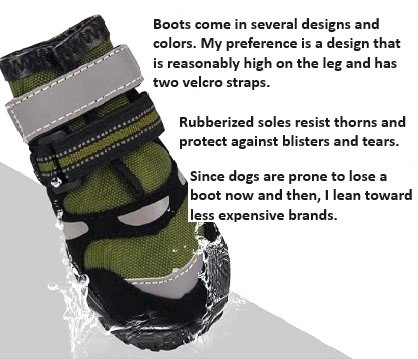Giving Your Dogs a Boot!
Keeping Their Best Foot Forward.
In some parts of the country, thorns are unavoidable.
Over many years and many - many - more miles, I have learned a thing or two about sound canine maintenance. Of course, whether I always put it to practice is another issue.
Take the paws of dogs for instance; where the rubber meets the road - to coin a phrase. After a day - or less - of hunting down the evil chukar partridge in their rugged and rocky lair, the pads on the bottom of a dog’s paws can pay a heavy price. Blistered and torn pads can put a dog off its feet for weeks; leaving you stranded at home reading my blogs instead of getting out hunting with your dog. (Perhaps, that could have been stated a bit differently?)
Now, there are several alternatives for “soft paws” and I believe that boots are among the last of all choices, not the “go-to” practice. If the dog has been properly maintained over the off months, runs and walks over hard surfaces such as pavement or concrete, then that may be all that’s required under normal upland conditions. If it is believed additional precautions are in order, the proper application of one of several pad-toughening concoctions available on the market is generally all the added protection dog paws require. Consistent use of dog boots will only hamper - not help - the process of conditioning their paws and may lead to other undesirable issues.
The presence of cactus, puncture weed, and other thorny plant-types or a day of running across jagged and rocky terrain often requires the use of rubber-soled boots to keep dogs going. In addition, wet snow conditions can ball-up ice between a dog’s toes and become a painful distraction. Lastly, it’s a good practice to have some form of dog boot in your med-kit to protect injured paws upon which ointments have been applied.
Among the many designs offered, I have found that most are designed for “princess-dog” walking in urban settings, so choose carefully. Some of the characteristics I look for in a boot are high enough on the leg to have two straps, support across the top of the paw, and rubberized soles. “Water Resistance” is of no value and, in fact, a bit of a down-side since dog’s paws are one of a few places where dogs perspire. Besides, when water is about, water resistance also means water retention. Therefore, when they fill with water - during stream crossings, for example - the boots will simply retain water; not often desirable in sub-freezing conditions. I believe a Roman-style sandal worthy of the outdoors would be a preferable design most often.
Often, a robust Roman-style sandal design would be preferrable to so-called “water-resistant” boots for dogs while hunting.
Remember, you heard that here first!
WEAR: Hunting with hard-charging pointing dogs (setters), I can expect about three or four days of use in conditions where cactus is the main concern; maybe, two in chukar-haunted canyons of basalt rock. You can add a few days of use by repairing loose soles and warn spots with Shoe-Goo; letting it set overnight. Clearing velcro straps from seeds and grime after each use will help keep straps useful.
APPLICATION: Use the manufacturer’s measurement chart carefully to select the best fitting boots for your dog(s). Don't be timid about tightness when strapping them on. The double-strap on boots have proven to be adequate enough to do the job but I will often add a strip of medical or duct tape around the top to adhere the boots to hair. This not only helps prevent loss but prevents the boot from spinning around the foot - placing sole on top of the foot.
Check fit and function carefully and often; dog boots are NOT set and forget. Continue to monitor the dog's stride and pace for signs of discomfort. Check paws frequently; I suggest every water break or so. DO NOT leave the boots on the dog for extended lengths of time. Remove the boots when not required, such as during long midday breaks, traveling (driving) a great distance, or overnight.
In harsh environs, it is extremely important to keep tabs on dog paws - boots or no. In the final analysis, when considering dog boots, I look for boots I can trust to protect my dogs at a price that I can live with.
In cactus-country, wearing boots can keep a smile on your dog’s face!
Enjoy Your Dog!




